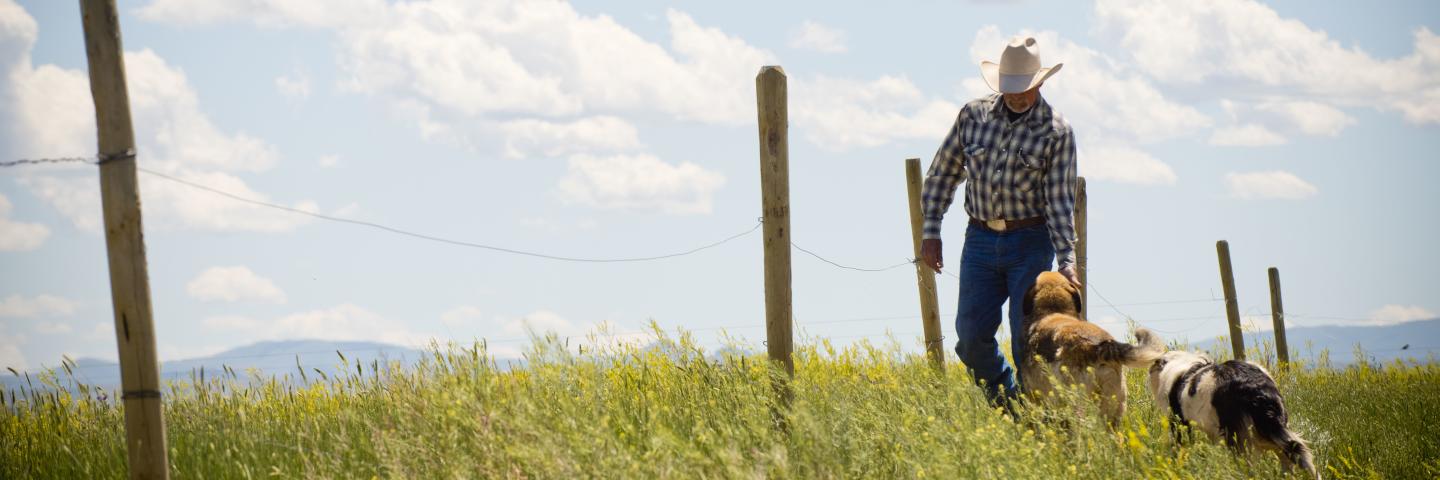
This Targeted Implementation Plan (TIP) is available in Missoula and Powell counties, Montana. TIPs are local-level Environmental Quality Incentives Program (EQIP) initiatives used by NRCS in Montana to guide on-the-ground implementation of locally developed Long Range County Plans.
Project Description
County or Counties: Powell and Missoula
Primary Resource Concern: Terrestrial Wildlife Habitat
Time Frame: Fiscal Year (FY) 2022 through FY 2026
EQIP funds will provide participants with financial assistance for installation of electric fences and electrified drive-over mats to deter grizzlies from entering areas of anthropogenic attractants with potential bear/human conflict. Reducing bear/human conflict is a key strategy to the recovery of the Northern Continental Divide Ecosystem population of grizzly bears. The geographic boundary of the TIP and the efficacy of the chosen conservation practices are supported by empirical data and real-world proven application by partners in the Blackfoot region of Montana.
Conservation Practices Offered
- 649 Structures for Wildlife, 5-wire fence
- 649 Structures for Wildlife, 12-foot electric drive-over mat
- 500 Obstruction Removal, fence removal
Detailed descriptions of these conservation practices can be found in the Field Office Technical Guide, Section 4 - Practice Standards and Supporting Documents.
Project Partners
- Montana Fish Wildlife and Parks
- Blackfoot Challenge
- United States Fish and Wildlife Service
Blackfoot Challenge video showcases Drive-Over Electric Mats Used for Deterring Grizzly Bears in Montana.
Grizzly Bear Collective article, "Riding the Fences: Listening and learning as a means to safely live with bears" by Jessianne Castle.
When to Apply
Program applications are accepted on a continual basis. However, NRCS establishes application dates for evaluation, ranking and approval of eligible applications. Applications received after that date will be automatically deferred to the next funding period. See Montana Programs and Application Dates.
Applications must meet the intent of this initiative. For more details about this initiative, contact your local field office.
Additional Montana Information
Targeted Implementation Plans (TIPs) are local-level Environmental Quality Incentives Program (EQIP) initiatives used by NRCS in Montana to guide on-the-ground implementation of locally developed Long Range County Plans. These plans are part of the "Focused Conservation” strategy to guide Montana's EQIP investments. Learn more about Montana Focused Conservation and Targeted Implementation Plans.
Information about payment schedules, priority resource concerns, other program and initiatives, and EQIP in general is available at Environmental Quality Incentives Program - Montana.
Additional Information
Apply for Environmental Quality Incentives Program (EQIP)
The Environmental Quality Incentives Program (EQIP) provides financial and technical assistance to agricultural producers and non-industrial forest managers.
Learn MoreHistorically Underserved Farmers and Ranchers
The Agriculture Improvement Act of 2018 (2018 Farm Bill) includes provisions that address socially disadvantaged, beginning, limited resource, and veteran farmers and ranchers (“historically underserved producers”).
Learn MoreFarm Bill
The 2018 Farm Bill was enacted on December 20, 2018. The Farm Bill continues its strong support for conservation efforts of America’s farmers and ranchers through reauthorization and expanded flexibility of NRCS conservation programs.
Learn MoreReady to get started?
Contact your local service center to start your application.
How to Get Assistance
Do you farm or ranch and want to make improvements to the land that you own or lease?
Natural Resources Conservation Service offers technical and financial assistance to help farmers, ranchers and forest landowners.

To get started with NRCS, we recommend you stop by your local NRCS field office. We’ll discuss your vision for your land.
NRCS provides landowners with free technical assistance, or advice, for their land. Common technical assistance includes: resource assessment, practice design and resource monitoring. Your conservation planner will help you determine if financial assistance is right for you.
We’ll walk you through the application process. To get started on applying for financial assistance, we’ll work with you:
- To fill out an AD 1026, which ensures a conservation plan is in place before lands with highly erodible soils are farmed. It also ensures that identified wetland areas are protected.
- To meet other eligibility certifications.
Once complete, we’ll work with you on the application, or CPA 1200.
Applications for most programs are accepted on a continuous basis, but they’re considered for funding in different ranking periods. Be sure to ask your local NRCS district conservationist about the deadline for the ranking period to ensure you turn in your application in time.
As part of the application process, we’ll check to see if you are eligible. To do this, you’ll need to bring:
- An official tax ID (Social Security number or an employer ID)
- A property deed or lease agreement to show you have control of the property; and
- A farm number.
If you don’t have a farm number, you can get one from USDA’s Farm Service Agency. Typically, the local FSA office is located in the same building as the local NRCS office. You only need a farm number if you’re interested in financial assistance.
NRCS will take a look at the applications and rank them according to local resource concerns, the amount of conservation benefits the work will provide and the needs of applicants. View Application Ranking Dates by State.
If you’re selected, you can choose whether to sign the contract for the work to be done.
Once you sign the contract, you’ll be provided standards and specifications for completing the practice or practices, and then you will have a specified amount of time to implement. Once the work is implemented and inspected, you’ll be paid the rate of compensation for the work if it meets NRCS standards and specifications.

